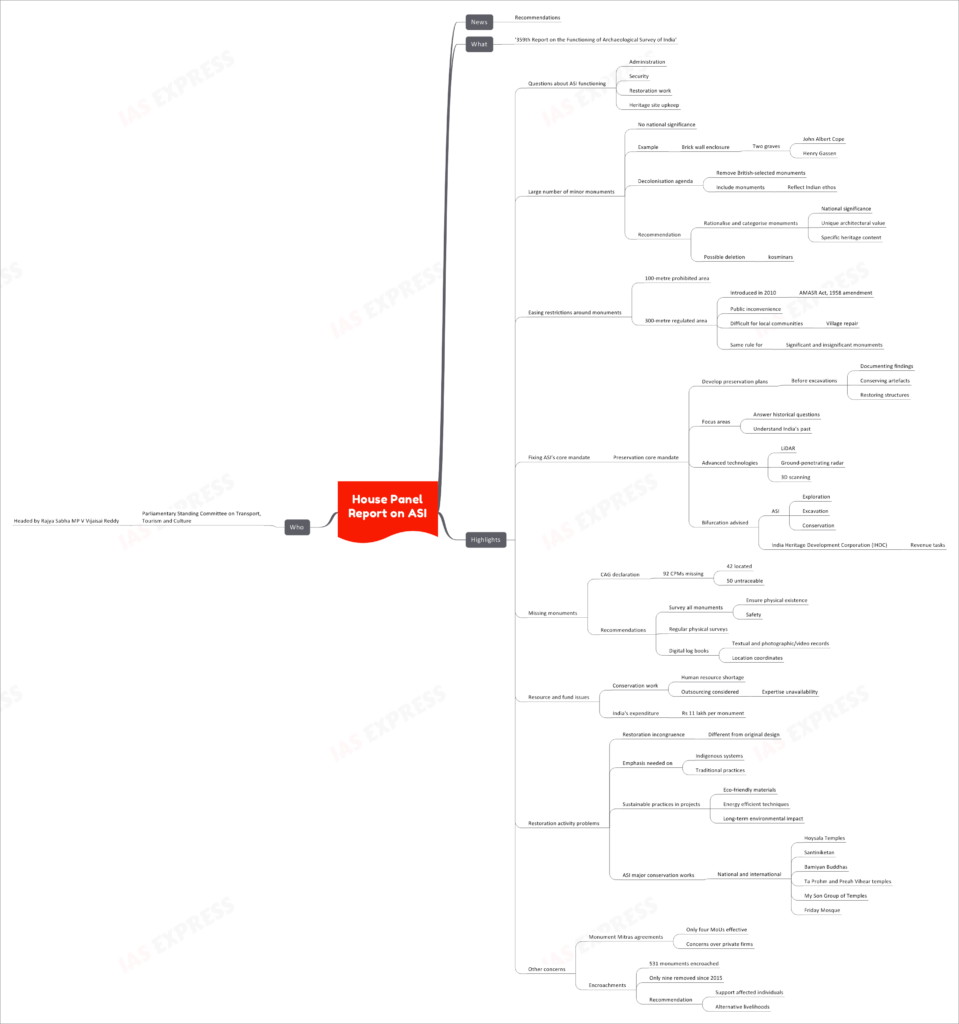House Panel Report on ASI

The Parliamentary Standing Committee on Transport, Tourism, and Culture, headed by Rajya Sabha MP V Vijaisai Reddy, has released its ‘359th Report on the Functioning of the Archaeological Survey of India (ASI).’ This report provides a comprehensive analysis of various aspects of ASI’s functioning, including its administration, security measures, restoration work, and heritage site upkeep. It also addresses issues related to minor monuments, easing restrictions around monuments, ASI’s core mandate, missing monuments, resource and fund allocation, restoration activity problems, and other concerns.
News Recommendations
The report offers a series of recommendations based on its findings and observations, aiming to enhance ASI’s efficiency and effectiveness in preserving India’s cultural heritage.
Highlights
Questions about ASI Functioning
- Administration: The report raises questions about the administration of ASI, including its organizational structure and decision-making processes.
- Security: Concerns regarding the security measures in place to protect heritage sites.
- Restoration Work: The quality and authenticity of restoration work carried out by ASI.
- Heritage Site Upkeep: The maintenance and upkeep of heritage sites under ASI’s jurisdiction.
Large Number of Minor Monuments
- No National Significance: Many minor monuments lack national significance and include examples like brick wall enclosures with two graves (e.g., John Albert Cope and Henry Gassen).
- Decolonization Agenda: The report suggests removing British-selected monuments and including those that reflect Indian ethos.
- Recommendation: Rationalizing and categorizing monuments based on national significance, unique architectural value, and specific heritage content. Possible deletion of monuments like kosminars.
Easing Restrictions Around Monuments
- Prohibited and Regulated Areas: The report questions the 100-meter prohibited and 300-meter regulated areas around monuments, which were introduced in 2010 through the AMASR Act, 1958 amendment.
- Inconvenience: Highlighting the public inconvenience and difficulties faced by local communities, especially in conducting village repairs.
- Uniform Rule: The need for a more nuanced approach, considering the significance of monuments.
Fixing ASI’s Core Mandate
- Preservation Core Mandate: Emphasizing ASI’s core mandate, which includes developing preservation plans, documenting findings, conserving artifacts, and restoring structures.
- Focus Areas: Focusing on answering historical questions and understanding India’s past.
- Advanced Technologies: The adoption of advanced technologies such as LiDAR, ground-penetrating radar, and 3D scanning.
- Bifurcation: The report suggests bifurcating responsibilities between ASI (exploration, excavation, conservation) and the India Heritage Development Corporation (IHDC) for revenue tasks.
Missing Monuments
- CAG Declaration: The Comptroller and Auditor General (CAG) declaration regarding missing monuments, with 92 Centrally Protected Monuments (CPMs) reported as missing.
- Recommendations: Recommending thorough surveys to ensure physical existence and safety, regular physical surveys, and digital logbooks with textual and photographic/video records.
Resource and Fund Issues
- Conservation Work: The report highlights human resource shortages in conservation work and considers outsourcing due to expertise unavailability.
- Expenditure: Revealing India’s expenditure of Rs 11 lakh per monument for conservation.
Restoration Activity Problems
- Restoration Incongruence: Concerns about restoration work being incongruent with the original design.
- Emphasis on Indigenous and Traditional Practices: The need to emphasize indigenous systems and traditional practices in restoration projects.
- Sustainable Practices: Encouraging the use of eco-friendly materials and energy-efficient techniques to minimize long-term environmental impact.
- ASI’s Major Conservation Works: Recognizing ASI’s conservation efforts in national and international landmarks like Hoysala Temples, Santiniketan, Bamiyan Buddhas, Ta Prohm and Preah Vihear temples, My Son Group of Temples, and the Friday Mosque.
Other Concerns
- Monument Mitras Agreements: The report highlights concerns about the effectiveness of Monument Mitras agreements, with only four Memoranda of Understanding (MoUs) currently in effect and concerns over private firms’ roles.
- Encroachments: Noting that 531 monuments are encroached upon, the report recommends supporting affected individuals and providing alternative livelihoods.
If you like this post, please share your feedback in the comments section below so that we will upload more posts like this.

